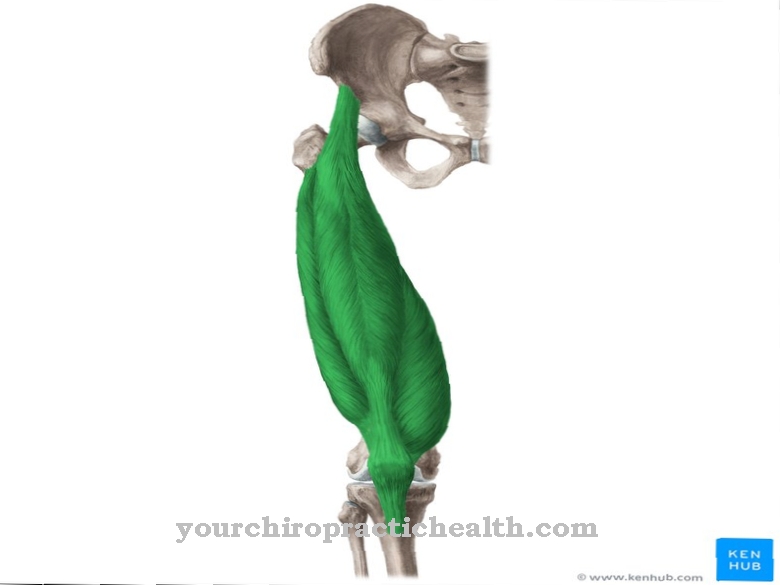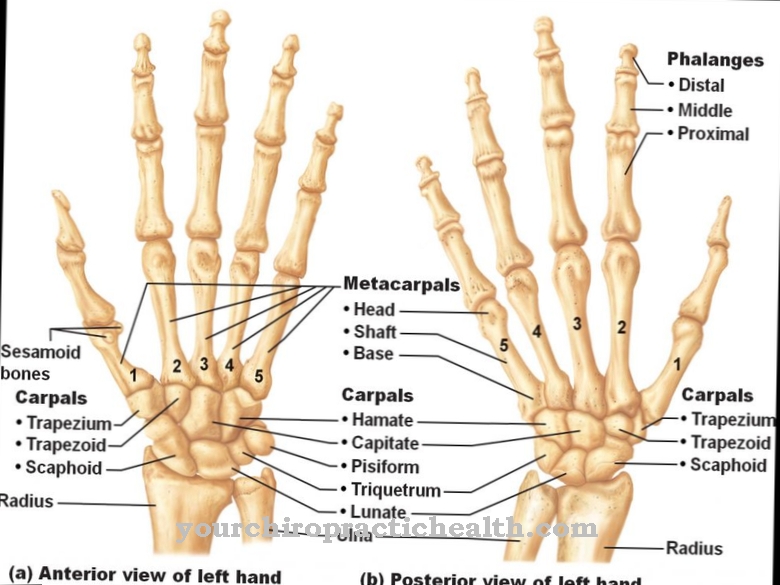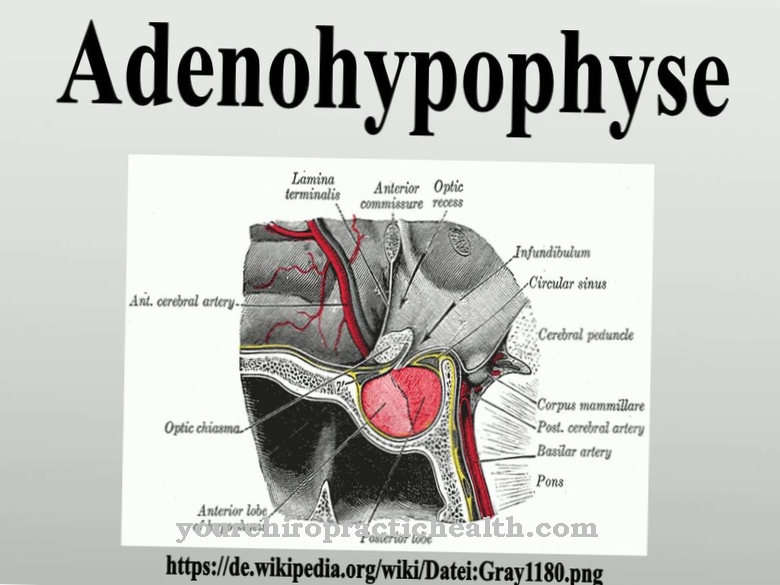The entrance area of the basal ganglia is that Striatum, also called Strip body is known. This part of the brain is networked with the motor nerve tracts and is the first switching point for the interconnection of targeted movements. Degenerations of the striatum can occur in the context of Parkinson's or Huntington's disease and usually have the effect of either hypo- or hyperkinesis.
What is the striatum?
The striatum or actually corpus striatum belongs to the basal ganglia and thus to the forebrain. It is also known in German as a striped body and forms the part on the side of the thalamus in each cerebral hemisphere. The radiation body plays a role specifically for the motor nervous system.
The five motor nerve tracts of the spinal cord can be divided into the two pyramidal tracts and the three extrapyramidal tracts. These nerves have their switching points in the brain. The striatum is one of the most important switching points, especially for the extrapyramidal pathways. It forms the entrance to the basal ganglia, where motivation, cognition, emotion and movement behavior are organized neuronally. As such, the basal ganglia are particularly responsible for targeted actions, control, decisions and movement plans. The output from this system stimulates certain muscles and thus enables the realization of voluntary movement plans.
Anatomy & structure
The caudate nucleus and the putamen each form a striatum. The putamen is part of what is known as gray matter. The caudate nucleus is its associated part of the white matter and in this sense belongs to the endbrain. The internal capsule delimits the caudate nucleus from the putamen.
It is a collection of nerve fibers that grow around the unit of putamen and nucleus caudatus in late embryonic development. This nerve fiber pathway is the longest stimulus-receiving pathway in the central nervous system. Despite the internal capsule, there is a connection between the putamen and the caudate nucleus in the form of fine strips of gray matter. On the abdomen, the nucleus accumbens connects the putamen with the nucleus caudatus.
The nucleus accumbens belongs to the mesolimbic system and, together with the nucleus basalis and part of the limbic amygdala, forms the substantia innominata. The striatum is equipped with many excitatory or glutamatergic nerve fibers from the cortex. In addition there are dopaminergic fibers of the substanceia nigra. In the case of the nerve cells of the stratium, the physician also speaks of spike neurons with a particularly fine dendrite structure.
Function & tasks
The striatum is the first switching point of the basal ganglia and thus gives the basal ganglia system input for processing certain projections. Thus, the interconnection of targeted movements begins in the strip body. The incoming projections into the straitum originate in particular from the cerebral cortex, the substantia nigra and the core areas of the central nervous system. The entry of these projections into the striatum is biochemical.
The neurotransmitter glutamate plays an important role in the stimulating fibers from the cortex. In contrast, the dopaminergic fibers from the substantia nigra are controlled by the neurotransmitter dopamine. In this system, the stratium has an inhibiting function on movements of the extrapyramidal system. This inhibition takes place via the release of the neurotransmitter GABA. The striatum inhibits the globus pallidus through efferent fibers and the substantia nigra through negative feedback. The striatum therefore receives an action plan from the cortex that relates to the execution of a movement.
This intention to move is conveyed to the radiation body via glutamate and shifts the sting neurons of the stratium. These inhibitory spine neurons then release the inhibitory transmitter GABA on the pale and black core of the brain. The black core now releases dopamine and thus inhibits the sting neurons that inhibit movement. The output from the basal ganglia runs through the pale nucleus and it comes to movement through the intermediate switch point of the inhibited spine neurons. The nucleus accumbens from putamen and nucleus caudatus, on the other hand, plays a role primarily in the reward system of the brain and thus also in the development of addiction. This area rewards certain behavior patterns with feelings of happiness and is the link between motor skills and emotions.
You can find your medication here
➔ Medicines for paresthesia and circulatory disordersDiseases
If structures of the feedback loop between the substantia nigra and the striatum are defective, a so-called hypokinesis occurs. With this clinical picture, there is decreased movement. Spontaneous motor skills decrease and general movement becomes mask-like and fragmented. Such hypokinesis may be due to degenerative diseases such as Parkinson's disease.
In hypokinesis caused by Parkinson's disease, the dopaminergic cells of the black nucleus are destroyed. Movements are only slowed down and the initiation of targeted movements is accompanied by tremors. Once the goal of movement is achieved, the tremor often subsides. For example, if you reach for a glass, you may experience tremors during the process. Nevertheless, once the goal has been achieved, it is often possible to drink normally. Similar to Parkinson's disease, Huntington's disease is often associated with degeneration of the striatum.
Instead of hypokinesis, hyperkinesis occurs in this clinical picture. This form of movement disorder is also known as motor restlessness. Such symptoms are usually related to degeneration of the GABA neurons in the striatum. Tremor in general can also result from a disorder of the striatum. A third example of diseases in this area of the brain is the so-called striatum syndrome.



























